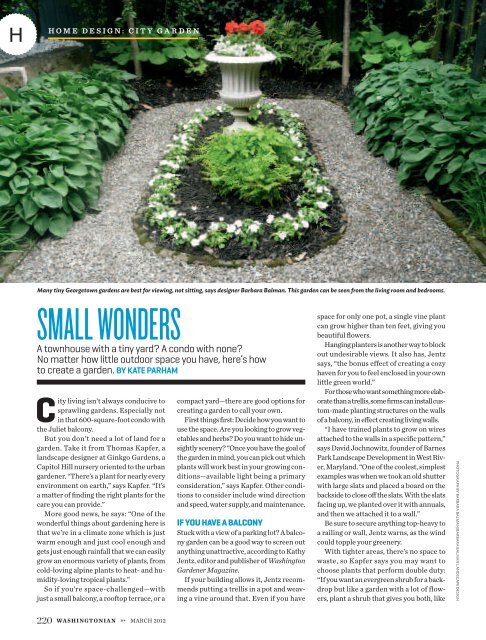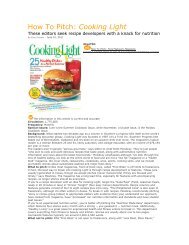You also want an ePaper? Increase the reach of your titles
YUMPU automatically turns print PDFs into web optimized ePapers that Google loves.
H<br />
Home Design: City Garden<br />
Many tiny Georgetown gardens are best for viewing, not sitting, says designer Barbara Balman. This garden can be seen from the living room and bedrooms.<br />
<strong>Small</strong> Wonders<br />
A townhouse with a tiny yard A condo with none<br />
No matter how little outdoor space you have, here’s how<br />
to create a garden. By <strong>Kate</strong> <strong>Parham</strong><br />
City living isn’t always conducive to<br />
sprawling gardens. Especially not<br />
in that 600-square-foot condo with<br />
the Juliet balcony.<br />
But you don’t need a lot of land for a<br />
garden. Take it from Thomas Kapfer, a<br />
landscape designer at Ginkgo Gardens, a<br />
Capitol Hill nursery oriented to the urban<br />
gardener. “There’s a plant for nearly every<br />
environment on earth,” says Kapfer. “It’s<br />
a matter of finding the right plants for the<br />
care you can provide.”<br />
More good news, he says: “One of the<br />
wonderful things about gardening here is<br />
that we’re in a climate zone which is just<br />
warm enough and just cool enough and<br />
gets just enough rainfall that we can easily<br />
grow an enormous variety of plants, from<br />
cold-loving alpine plants to heat- and humidity-loving<br />
tropical plants.”<br />
So if you’re space-challenged—with<br />
just a small balcony, a rooftop terrace, or a<br />
compact yard—there are good options for<br />
creating a garden to call your own.<br />
First things first: Decide how you want to<br />
use the space. Are you looking to grow vegetables<br />
and herbs Do you want to hide unsightly<br />
scenery “Once you have the goal of<br />
the garden in mind, you can pick out which<br />
plants will work best in your growing conditions—available<br />
light being a primary<br />
consideration,” says Kapfer. Other conditions<br />
to consider include wind direction<br />
and speed, water supply, and maintenance.<br />
If You Have a Balcony<br />
Stuck with a view of a parking lot A balcony<br />
garden can be a good way to screen out<br />
anything unattractive, according to Kathy<br />
Jentz, editor and publisher of Washington<br />
Gardener Magazine.<br />
If your building allows it, Jentz recommends<br />
putting a trellis in a pot and weaving<br />
a vine around that. Even if you have<br />
space for only one pot, a single vine plant<br />
can grow higher than ten feet, giving you<br />
beautiful flowers.<br />
Hanging planters is another way to block<br />
out undesirable views. It also has, Jentz<br />
says, “the bonus effect of creating a cozy<br />
haven for you to feel enclosed in your own<br />
little green world.”<br />
For those who want something more elaborate<br />
than a trellis, some firms can install custom-made<br />
planting structures on the walls<br />
of a balcony, in effect creating living walls.<br />
“I have trained plants to grow on wires<br />
attached to the walls in a specific pattern,”<br />
says David Jochnowitz, founder of Barnes<br />
Park Landscape Development in West River,<br />
Maryland. “One of the coolest, simplest<br />
examples was when we took an old shutter<br />
with large slats and placed a board on the<br />
backside to close off the slats. With the slats<br />
facing up, we planted over it with annuals,<br />
and then we attached it to a wall.”<br />
Be sure to secure anything top-heavy to<br />
a railing or wall, Jentz warns, as the wind<br />
could topple your greenery.<br />
With tighter areas, there’s no space to<br />
waste, so Kapfer says you may want to<br />
choose plants that perform double duty:<br />
“If you want an evergreen shrub for a backdrop<br />
but like a garden with a lot of flowers,<br />
plant a shrub that gives you both, like<br />
Photograph by Barbara Balman/Barbara Balman Landscape Design<br />
220 Washingtonian ➳ March 2012
➳<br />
Photograph of plants under tree courtesy of Tom Hammond/Ginkgo Gardens; window Box by KAthy Jentz/Washington Gardener<br />
a camellia.” Or you can plant something<br />
with both form and function, such as fruit<br />
trees—apples, pears, and peaches are best—<br />
which are available in dwarf forms and can<br />
be grown on walls, showing off a colorful<br />
flower display in spring before bearing fruit<br />
later in the season.<br />
If You Have a Roof<br />
For those who live in a townhouse or a<br />
building that allows residents to garden<br />
on a roof terrace, there are a few things<br />
to keep in mind, including the weight the<br />
roof can support and water availability. The<br />
good news is that there likely will be more<br />
space than on a balcony, and a rooftop garden<br />
might have environmental benefits.<br />
Vegetable gardens are good options for<br />
rooftop terraces, as they will get full sunlight<br />
and don’t have to take up a lot of space.<br />
Herbs and vegetables grow well in pots.<br />
Says Jentz: “Classic edible containers include<br />
the ‘pizza garden,’ which includes tomatoes,<br />
peppers, onions, and herbs such as<br />
oregano and basil, or the ‘griller’s herb box,’<br />
which can have lemon verbena and dill for<br />
fish, tarragon or sage for chicken, rosemary<br />
for pork, and thyme for beef.”<br />
As with a balcony, dwarf fruit trees are<br />
good options that provide both edibles and<br />
ornaments. Don’t forget about vegetables<br />
with decorative value, Kapfer says, such as<br />
rainbow Swiss chard, red and purple lettuces,<br />
and even okra, which offers big, pretty,<br />
tropical flowers.<br />
If you have the option, consider installing<br />
a green roof, says Barbara Balman of<br />
Barbara Balman Landscape Design. A<br />
green roof is partially or completely covered<br />
with vegetation as well as a growing<br />
medium, and it serves many purposes, including<br />
absorbing rainwater; providing insulation;<br />
creating a habitat for wildlife such<br />
as birds, butterflies, and insects; and helping<br />
to lower urban air temperatures. For an<br />
example, you can check out a green roof at<br />
George Washington University by visiting<br />
facilities.gwu.edu/greenroof. For more information<br />
and advice, see greenroofs.org.<br />
The most important thing is to create a<br />
space you can enjoy, especially if you have<br />
a great view. Even a garden consisting of<br />
a few pots and some chairs can be an outdoor<br />
oasis. For something more extensive,<br />
consider investing in raised planting beds,<br />
overhead structures such as pergolas for<br />
shade, and even fountains and pools.<br />
If You Have a <strong>Small</strong> Yard<br />
While all of the options for balconies and<br />
rooftop gardens work for small yards,<br />
you’ll likely have more space to play with<br />
on the ground.<br />
For a calming environment, you might<br />
opt for one or two varieties of a plant in a<br />
single type of pot. Prefer something more<br />
Ways to garden in<br />
small spaces: The<br />
base of the tree at<br />
right is planted with<br />
hosta, liriope, and<br />
more. Below: You<br />
can hide an ugly<br />
view with planters<br />
hung along a fence.<br />
And herbs grow well<br />
in containers.<br />
dramatic Combine plants in pots with this<br />
gardening formula: thriller, filler, spiller.<br />
A “thriller” plant, says Kapfer, has<br />
height, architectural structure, and visual<br />
impact—think cannas, yuccas, and purple<br />
fountain grass. Pillowy, mounding “filler”<br />
plants, such as the brightly colored foliage<br />
of coleus and Persian shield, create atmosphere<br />
and substance. “Spiller” plants,<br />
such as sweet-potato vine or trailing nasturtium,<br />
cascade over the edge and soften<br />
the container.<br />
If you want a lush oasis, Kapfer suggests<br />
layering small trees such as crape myrtles<br />
with midlevel shrubs—for example, dwarf<br />
oak-leaf hydrangeas or evergreen hollies.<br />
Then tuck in perennials and annuals to fill<br />
out the planting.<br />
If you have an outdoor space but no yard<br />
to plant, there are still options. Kapfer says<br />
rock and gravel gardens can support succulents<br />
such as sedums and cacti as well as<br />
alpine plants and cool-climate bulbs that<br />
grow with little soil, including crocuses,<br />
grape hyacinths, scilla, species tulips, and<br />
Iris reticulata.<br />
Jentz agrees: “Picking drought-tolerant<br />
plants accustomed to wind and sun exposure<br />
can be attractive and low-maintenance.”<br />
Another good option is ornamental<br />
grasses, which come in many varieties and<br />
are some of the lowest-maintenance plants<br />
you can grow. You can use them as focal<br />
points or to add texture and atmosphere<br />
to your garden.<br />
Ornamental grasses have the advantage<br />
of staying visually interesting all winter.<br />
“They break up the concrete feeling of<br />
being in a building,” says Balman. “Even if<br />
there’s snow on the ground, you have interesting<br />
lines in the landscape.”<br />
<strong>Kate</strong> <strong>Parham</strong> (katemparham@gmail.com)<br />
is a Washington writer whose work has appeared<br />
in USA Today, Cooking Light, and<br />
Real Simple.<br />
March 2012<br />
washingtoniaN 221




